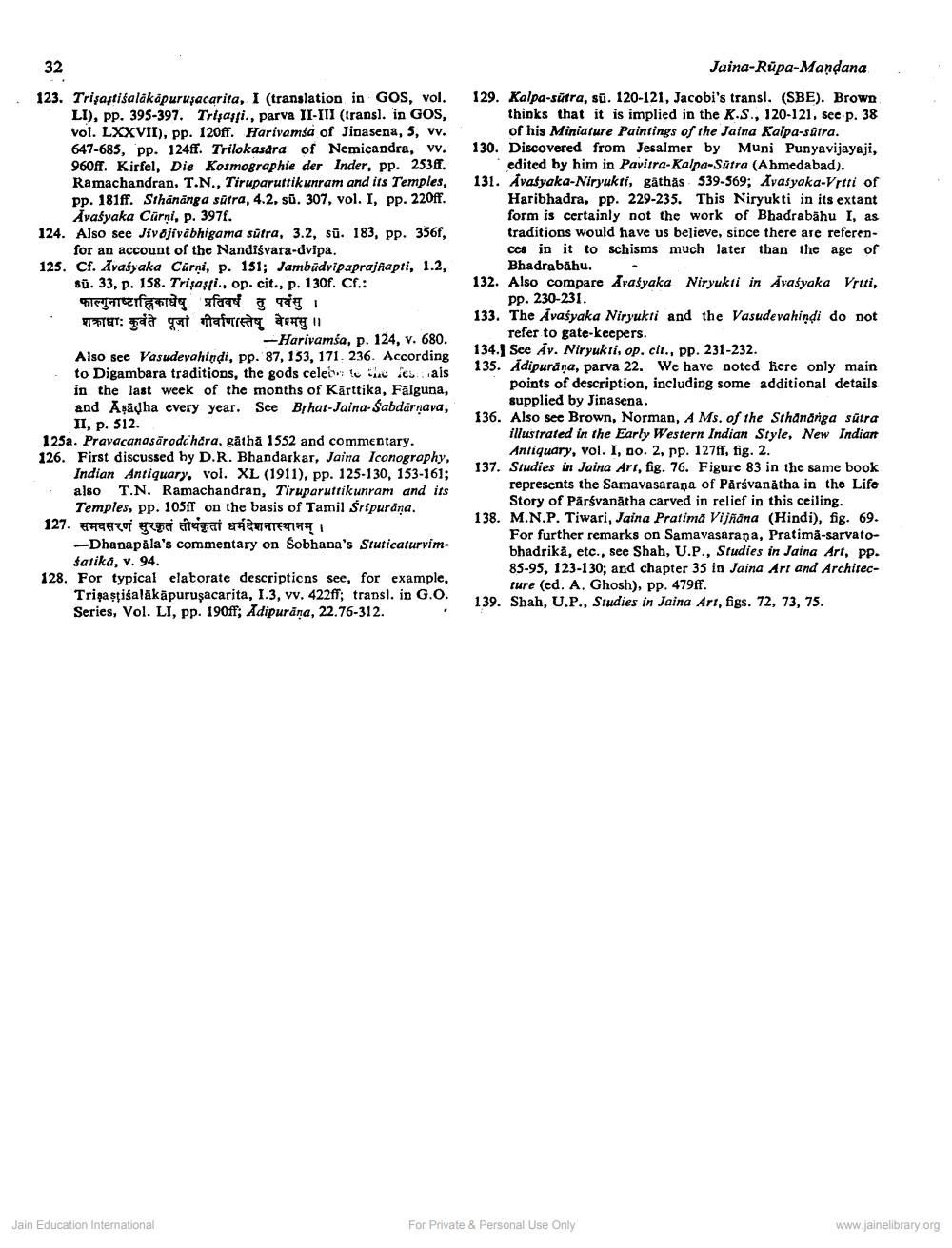________________
123. Trişastišalákāpuruşacarita, I (translation in GOS, vol.
LI), pp. 395-397. Trisasi., parva II-III (transl. in GOS, vol. LXXVII), pp. 120ff. Harivamsa of Jinasena, 5, v. 647-685, pp. 124ff. Trilokasära of Nemicandra, v. 960ff. Kirfel, Die Kosmographie der Inder, pp. 253. Ramachandran, T.N., Tiruparuttik unram and its Temples, pp. 181ff. Sthänänga sätra, 4.2, sū. 307, vol. I, pp. 220ff.
Avašyaka Cūrni, p. 3978. 124. Also see Jivojivabhigama sutra, 3.2, sü. 183, pp. 356,
for an account of the Nandiśvara-dvipa. 125. Cf. Avasyaka Cürni, p. 151; JambūdvipaprajAapti, 1.2,
sü. 33, p. 158. Trisaspi., op. cit., p. 130f. Cf.: फाल्गुनाष्टाह्निकाधेषु प्रतिवर्ष तु पर्वसु । शक्राधा: कुर्वते पूजां गीर्वाणास्तेषु वेश्मसु ।।
-Harivamsa, p. 124, v. 680. Also see Vasudevahindi, pp. 87, 153, 171. 236. According to Digambara traditions, the gods celeb: to the leais in the last week of the months of Kärttika, Fälguna, and Așadha every year. See Brhat-Jaina-Sabdarnava,
II, p. 512. 125a. Pravacanasārodc hara, gātha 1552 and commentary. 126. First discussed by D.R. Bhandarkar, Jaina Iconography,
Indian Antiquary, vol. XL (1911), pp. 125-130, 153-161; also T.N. Ramachandran, Tiruparuttikunram and its
Temples, pp. 105ff on the basis of Tamil Sripurana. 127. #
Hugga ugat CuaT71 -Dhanapala's commentary on Sobhana's Stuticaturvim
fatika, v. 94. 128. For typical elaborate descriptions see, for example,
Triņaspisalākāpuruşacarita, 1.3, v. 422ff; transl. in G.O. Series, Vol. LI, pp. 190ff; Adipuräna, 22.76-312.
Jaina-Rupa-Mandana 129. Kalpa-sútra, sü. 120-121, Jacobi's transl. (SBE). Brown
thinks that it is implied in the K.S., 120-121, see p. 38
of his Miniature Paintings of the Jaina Kalpa-sútra. 130. Discovered from Jesalmer by Muni Punyavijayaji,
edited by him in Pavitra-Kalpa-Sätra (Ahmedabad). 131 Avasyaka-Niryukri, gathas 539-569; Ivasyaka-Vrtti of
Haribhadra, pp. 229-235. This Niryukti in its extant form is certainly not the work of Bhadrabahu I, as traditions would have us believe, since there are references in it to schisms much later than the age of
Bhadrabahu. . 132. Also compare Avašyaka Niryukli in Avašyaka Vrtti,
pp. 230-231. 133. The Avašyaka Niryukti and the Vasudevahindi do not
refer to gate-keepers. 134.] See Av. Niryukti, op. cit., pp. 231-232. 135. Adipuraņa, parva 22. We have noted here only main
points of description, including some additional details
supplied by Jinasena. 136. Also see Brown, Norman, A Ms. of the Sthanariga sutra
illustrated in the Early Western Indian Style, New Indian
Antiquary, vol. I, no. 2, pp. 127ff, fig. 2. 137. Studies in Jaina Art, fig. 76. Figure 83 in the same book
represents the Samavasarana of Parsvanátha in the Life
Story of Pārsvanātha carved in relief in this ceiling. 138. M.N.P. Tiwari, Jaina Pratima Vijana (Hindi), fig. 69.
For further remarks on Samavasarana, Pratimă-sarvatobhadrika, etc., see Shah, U.P., Studies in Jaina Art, pp. 85-95, 123-130; and chapter 35 in Jaina Art and Architec
ture (ed. A. Ghosh), pp. 479ff. 139. Shah, U.P., Studies in Jaina Art, figs. 72, 73, 75.
Jain Education International
For Private & Personal Use Only
www.jainelibrary.org




